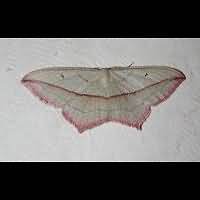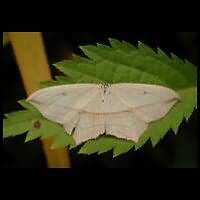Blood-vein (Timandra comae)
The Blood-vein in its typical colouring is not very difficult to identify. Depending on the light the basic colour is a silvery white to a creamy white. There is a straight, dark red line running from the hook at the front wing to the edge of the hind wing. It seemingly runs through from front wint to hind wing. A smaller grey line runs below it, almost parallel, but more curved. Of all similar species it is the only one where the dark line starts in the tip of the wing. In fresh specimens the lower edges of the wings are also strikingly coloured: reddish or pinkish. There is a second dark line, often less red running over the wing, starting somewhere half way the body. Between the two lines each wing shows one dark dot. In some specimens, especially older ones, the pink at the edges of the wings is gone and the colour of the dark line is just a dull brown. The upper line has faded or become invisible and so have the dots. In these cases the grey paralel line is often faded as well, but still quite visible. These animals are stil easily identified by the straight line. The wingspan of this species is some 30 to 35 mm.
As the Blood-vein is double-brooded, the eggs are deposited in spring (May and June) and in late summer August and September. They hatch in about 10 days. The larvae may reach a length of some 23 mm. Yhey are reddish brown, brownish or greyish with a few white lines on the sides and a dark pattern on the back. Looking up front they are similar to a cobra, because the body is swollen just behind the brown head. Pupation takes place near the ground in plant debris. They may be found on quite a few host plants, especially knotgrass, dock and orache.
The two generations may overlap and thus the Blood-vein can be seen from the end of May to September. Usually there is a peak in June and July. Common in England and Wales, but rarer northwards. Very rare in Eastern Scotland and a local species in Ireland. The scientific name of this animal may be confusing, for it is still frequently referred to as Timandra griseata (even in Skinner's book). Untill a few years ago Timandra griseata used to be its scientific name. But then it was discovered there are actually two separate species which can not be told apart by just looking at them. One species lives in Northern and Eastern Europe and remained named Timandra griseata. The other species lives in Western and Southern Europe and was renamed to Timandra comae. Luckily there is only one species in both Britain and the Benelux: Timandra comae.
The Blood-vein in its typical colouring is not very difficult to identify. Depending on the light the basic colour is a silvery white to a creamy white. There is a straight, dark red line running from the hook at the front wing to the edge of the hind wing. It seemingly runs through from front wint to hind wing. A smaller grey line runs below it, almost parallel, but more curved. Of all similar species it is the only one where the dark line starts in the tip of the wing. In fresh specimens the lower edges of the wings are also strikingly coloured: reddish or pinkish. There is a second dark line, often less red running over the wing, starting somewhere half way the body. Between the two lines each wing shows one dark dot. In some specimens, especially older ones, the pink at the edges of the wings is gone and the colour of the dark line is just a dull brown. The upper line has faded or become invisible and so have the dots. In these cases the grey paralel line is often faded as well, but still quite visible. These animals are stil easily identified by the straight line. The wingspan of this species is some 30 to 35 mm.
As the Blood-vein is double-brooded, the eggs are deposited in spring (May and June) and in late summer August and September. They hatch in about 10 days. The larvae may reach a length of some 23 mm. Yhey are reddish brown, brownish or greyish with a few white lines on the sides and a dark pattern on the back. Looking up front they are similar to a cobra, because the body is swollen just behind the brown head. Pupation takes place near the ground in plant debris. They may be found on quite a few host plants, especially knotgrass, dock and orache.
The two generations may overlap and thus the Blood-vein can be seen from the end of May to September. Usually there is a peak in June and July. Common in England and Wales, but rarer northwards. Very rare in Eastern Scotland and a local species in Ireland. The scientific name of this animal may be confusing, for it is still frequently referred to as Timandra griseata (even in Skinner's book). Untill a few years ago Timandra griseata used to be its scientific name. But then it was discovered there are actually two separate species which can not be told apart by just looking at them. One species lives in Northern and Eastern Europe and remained named Timandra griseata. The other species lives in Western and Southern Europe and was renamed to Timandra comae. Luckily there is only one species in both Britain and the Benelux: Timandra comae.






